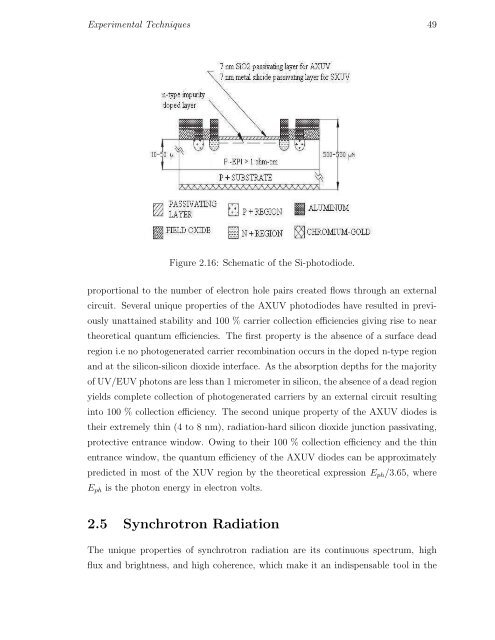PHYS07200604007 Manas Kumar Dala - Homi Bhabha National ...
PHYS07200604007 Manas Kumar Dala - Homi Bhabha National ...
PHYS07200604007 Manas Kumar Dala - Homi Bhabha National ...
You also want an ePaper? Increase the reach of your titles
YUMPU automatically turns print PDFs into web optimized ePapers that Google loves.
Experimental Techniques 49<br />
Figure 2.16: Schematic of the Si-photodiode.<br />
proportional to the number of electron hole pairs created flows through an external<br />
circuit. Several unique properties of the AXUV photodiodes have resulted in previously<br />
unattained stability and 100 % carrier collection efficiencies giving rise to near<br />
theoretical quantum efficiencies. The first property is the absence of a surface dead<br />
region i.e no photogenerated carrier recombination occurs in the doped n-type region<br />
and at the silicon-silicon dioxide interface. As the absorption depths for the majority<br />
of UV/EUV photons are less than 1 micrometer in silicon, the absence of a dead region<br />
yields complete collection of photogenerated carriers by an external circuit resulting<br />
into 100 % collection efficiency. The second unique property of the AXUV diodes is<br />
their extremely thin (4 to 8 nm), radiation-hard silicon dioxide junction passivating,<br />
protective entrance window. Owing to their 100 % collection efficiency and the thin<br />
entrance window, the quantum efficiency of the AXUV diodes can be approximately<br />
predicted in most of the XUV region by the theoretical expression E ph /3.65, where<br />
E ph is the photon energy in electron volts.<br />
2.5 Synchrotron Radiation<br />
The unique properties of synchrotron radiation are its continuous spectrum, high<br />
flux and brightness, and high coherence, which make it an indispensable tool in the
















